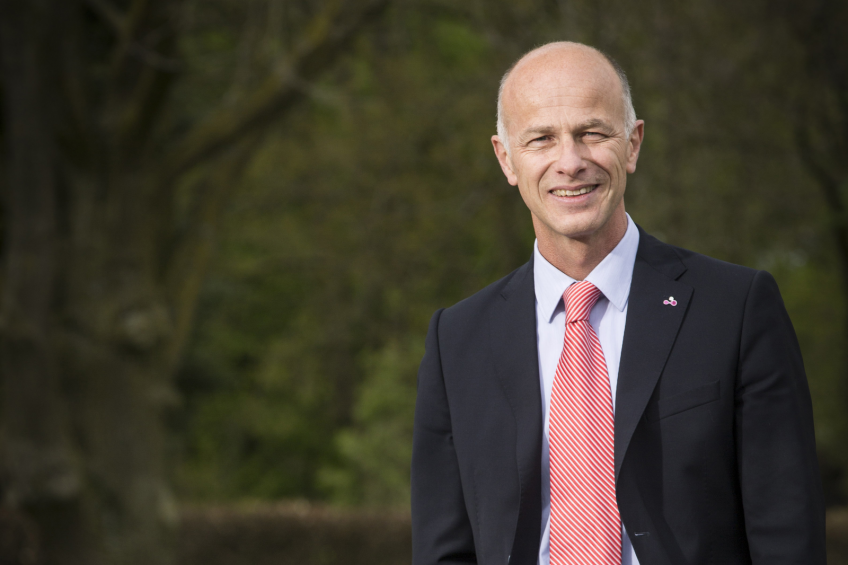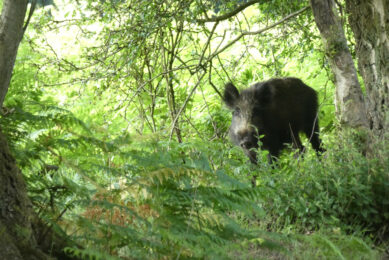“Breeding is more than aiming for good FCR”

In mid 2014, breeding companies Topigs (the Netherlands) and Norsvin (Norway) announced their merger. More than one year later, Martin Bijl, CEO of newly formed Topigs Norsvin looks back and points to the increased genetic progress.
Every time the merger of breeding organisations Topigs and Norsvin is the topic of conversation, CEO Martin Bijl continues to emphasise how many good things have been achieved due to the merger. There is more money for research. The product portfolio is wider. Knowledge has been gained. And most importantly: staff feel at home in the new company. The merger was made public last year at the World Pork Expo in Iowa, US. As from that moment, the international department of Dutch breeding organisation Topigs as well as Norsvin, a breeding company from Norway, formed one company. In 2014, Topigs Norsvin sold 8 million doses of semen; around the globe, four million sows were active in having genes of the new breeding company. Altogether, they produced 100 million finishers; and the company is active in more than 50 countries in six continents. Bijl has been CEO for seven years – he started out as CEO for Topigs only, since last year he has been heading the combined organisation after the merger. He is keen on working according to plan and reason; using drawings and sheets, he explains the company’s direction. As the company presented positive figures, Bijl has reason to look back with pride to the combined company’s first full year.
Martin Bijl at the World Pork Expo 2014, when the merger of Topigs and Norsvin was announced.
What results did the company make?
Martin Bijl: “Last year, Topigs Norsvin achieved a 10% autonomous revenue growth. Core activities (genetics and artificial insemination, AI) yielded money. In 2014, we had a good operational year.” Where did profits go to? “The money is mainly spent on research & development. In 2014, Topigs Norsvin’s joint budget for R&D was €18 million. We aim for €21 million budget in 2018; this year’s budget is €19 million. Roughly, that is 14% of revenue. At Topigs Norsvin only, 25 PhD geneticists are working full time to fuel further improvement. Our vision is to double the annual genetic progress on the crossbreed, farm level – using more and more real life commercial production data and genomic selection to get there.”
Martin Bijl
Martin Bijl, 51, has been CEO for pig breeding organisation Topigs Norsvin since mid 2014. Prior to this, he was head of the Dutch breeding organisation Topigs. Since the merger, the company has been headquartered in Vught, the Netherlands. Prior to joining Topigs, he was a member of the board of Royal Barenbrug Group, a global plant breeding company.
How much are genetics likely to change over the coming years?
“Genetic progress is going fast. Faster than ever. Only by introducing genomic selection we are able to boost genetic progress up to 40%; new models for breeding value estimation and other new technologies will create additional progress. For example we expect an improvement in feed conversion rate of about 15% in the next ten years. But not only better results will be seen, also traits like robustness and longevity will further improve in our products.”
Will piglet production continue to rise?
“Sure, on the condition that pre-weaning mortality percentages will not rise and that sows can lactate all piglets themselves. I choose not to look ten years into the future in this respect. Over the last years we have been able to grow the average number of pigs weaned per sow per year by 0.4. This trend will continue, without any doubt there is room for more improvement. Piglet production is an important economic element in pig production. Relatively, the importance of one piglet extra reduces when production is already high in itself.”
Many sow breeders are facing a lot of trouble getting all piglets weaned properly. Haven’t we just reached the limits of what is possible?
“I don’t think so. I acknowledge that it is a challenge to wean all piglets well and healthy from their own mothers. Still, it is possible. Annually, we weigh more than 700,000 piglets at breeding farms worldwide to be able to support data that shows that mothers can do it, and to demonstrate their piglets’ vitality. That is how we select the right animals for future generations. In our breeding targets, we aim for sows that can raise their own piglets without external help. Both in theory as well as in practice, we can prove that sows are still capable of raising their own piglets.”
“Without any doubt there is room for more improvement.”
Will the merger result in new breeding lines?
“Topigs Norsvin currently has nine breeding lines: four sire lines and five dam lines. At the moment, we are testing a potential new combination between Topigs and Norsvin lines. One new product is the TN70, which we are testing on a large scale now and plan to introduce in several markets in 2016. At the moment we are testing this new product in several countries and the first results are very promising. The TN70 seems to give a tremendous impact to the finisher in FCR, growth and meat content. The new female is already launched in Scandinavia and in the US with great success.”
What else has the merger brought?
“What is special is that its main driver has been to generate added value, not so much to reduce costs. That can be translated into more rapid genetic progress and as well meeting our foreign growth ambitions. It is our goal to achieve 7% year-on-year growth and we would like to do that in a market which is strongly consolidating. One of the developments we observe on a global scale is that pig production is going to become more integrated, in various shapes and forms. Large customers usually sign long term contracts. They test our pigs and would like to know what projects we work on behind the scenes. That way, they know what developments are about to happen with regards to our genetics. We are now capable of showing a large research group with almost 100 people working at product improvement.”
Why did you announce the merger in the United States?
“That was not a deliberate choice, it just happened to be convenient timing. In the middle of 2014 we had reached a stage at which everything could be signed. World Pork Expo in Des Moines proved to be the right platform to break the news. The merger led to a lot of media attention. The lion’s share of our revenue may come from Europe, but the American continent is our most important growth market for the coming years. In the US, we expect to be able to make the most of the advantage of working together. The majority of the 20 major players in the US swine market is a Topigs Norsvin user now. Worldwide, one in seven pigs has Topigs-Norsvin genetics.”
“The American continent is our most important foreign growth market for the coming years.”
What kind of pig are you breeding for the future?
“In general you can say that we breed our pigs based on the future global demand, and that is mainly improving feed efficiency in all aspects. We have been working with feeding stations on our breeding farms for many years to register both growth and feed usage. The Norsvin lines have even been monitored since 1992.
One should also think of harvesting pigs at a heavier weight, maintaining the lean meat percentage as well as easy to manage pig characters. After all, labour is scarce and expensive. For Topigs Norsvin, improving total feed efficiency means more than just attention to FCR of finishers. Of course FCR is and stays an important element in our breeding goal. We also see beyond that. With our ‘Total Feed Efficiency’ concept we also look at for example longevity and mortality of sows, piglets and finishers. We look to the whole production and minimise any ‘feed leakages’.
Genetic selection has become an important component in our breeding, it will lead to 30% quicker achievement of our breeding goals. And above all: we should always be focused at the market. What will customers demand in the year 2025? That question is key in defining our breeding goals.”
One more trend is ongoing consolidation, you said. What does that mean for Topigs Norsvin?
“In the long run, no doubt there will be other breeding organisations joining us. Breeding companies will have more and more difficulties accessing a strong R&D programme and R&D network, ensuring a high genetic progress. The investments in technology like genomic selection and data processing are huge. Topigs Norsvin is open to those new partnerships. I am more than satisfied when I look back at last year’s merger.”











